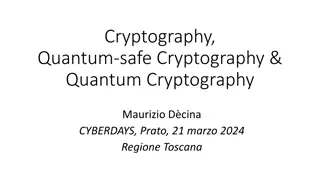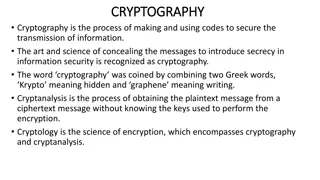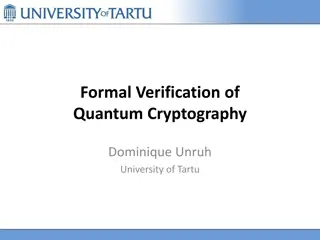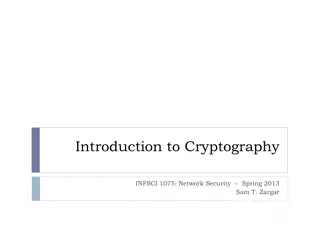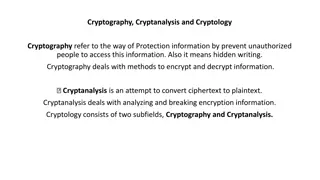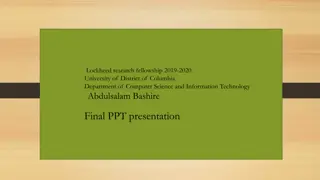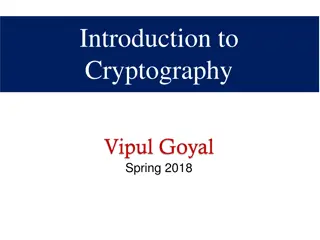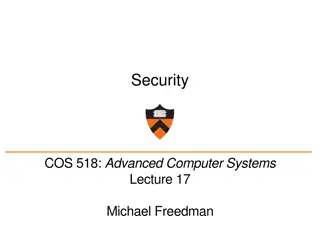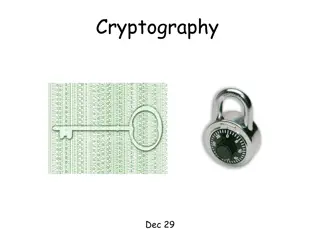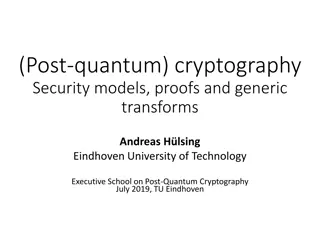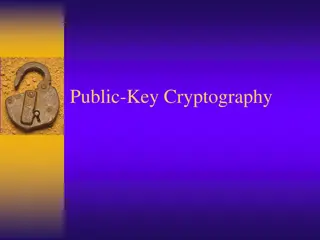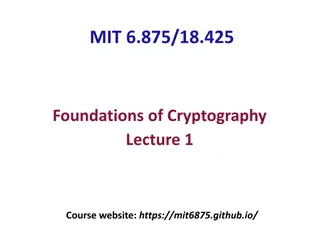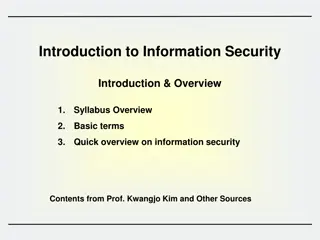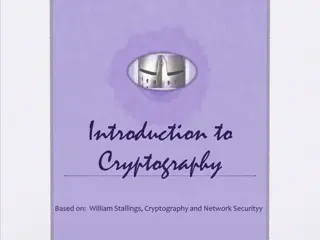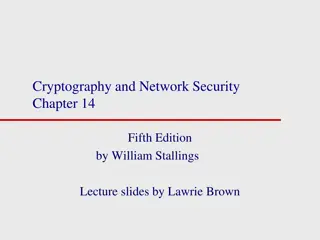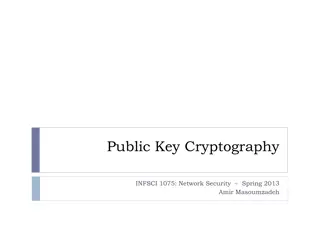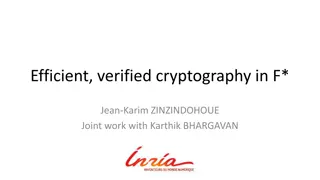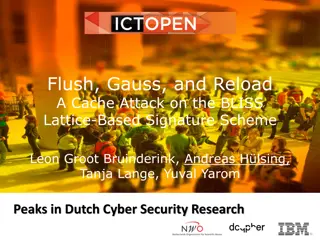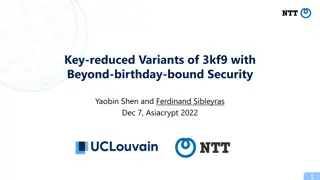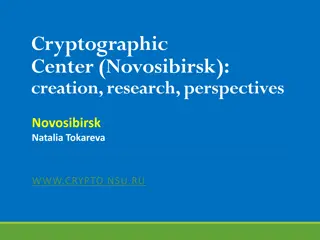Cryptography and Information Security Fundamentals
Explore the fundamental concepts of cryptography and information security, including Shannon's Coding Theorems, secure communication terminology, and information security concerns related to confidentiality, authenticity, and integrity. Dive into topics like compression for efficient communication, protection against noise, and encryption for secure communication.
Download Presentation

Please find below an Image/Link to download the presentation.
The content on the website is provided AS IS for your information and personal use only. It may not be sold, licensed, or shared on other websites without obtaining consent from the author. Download presentation by click this link. If you encounter any issues during the download, it is possible that the publisher has removed the file from their server.
E N D
Presentation Transcript
2ITX0 Applied Logic Quartile 2, 2019 2020 Lecture 8: Cryptography Lecturer: Tom Verhoeff
Road Map for Information Theory Theme Sender Channel Receiver Storer Memory Retriever Problem: Communication and storage of information Not modified by computation, but communicated/stored as is Lecture 5: A quantitative theory of information Lecture 6: Compression for efficient communication Lecture 7: Protection against noise for reliable communication Lecture 8: Protection against adversary for secure communication
Shannons Coding Theorems Source Coding Theorem (Shannon, 1948): There is a precise limit on compression: the source entropy Sender Encoder Channel Decoder Receiver Channel Coding Theorem (Shannon, 1948): There is a precise limit on efficiency loss on a noisy channel to achieve (almost 100%) reliability: the effective channel capacity Sender Encoder Channel Decoder Receiver Noise
Secure Communication Situation and terminology Sender Alice; Receiver Bob; Enemy Eve (eavesdropper) Unencoded / decoded message plaintext Encode / decode encrypt / decrypt (or sign / verify) Encoded message ciphertext (or signature) Eve Enemy Alice Bob Sender Encoder Channel Decoder Receiver Plaintext Encrypt Ciphertext Decrypt Plaintext Sign Signature Verify
Information Security Concerns Confidentiality: enemy cannot obtain information from message E.g. also not partial information about content 1. Authenticity: enemy cannot pretend to be a legitimate sender E.g. send a message in name of someone else 2. Integrity: enemy cannot tamper with messages on channel E.g. replace (part of) message with other content unnoticed 3. Enemy Enemy Enemy 1. 2. 3. Channel Channel Channel
Can Compression Provide Confidentiality? What are the symbol statistics after good compression? In favor: Result looks random: P(0) P(1) , etc. Against: the compression algorithm will become known Against: Obscurity Security
Kerckhoffs Principle (1883) Kerckhoffs: A cryptosystem should be secure, even if everything about the system, except the key, is public knowledge The security should be in the difficulty of getting the secret key Shannon: the enemy knows the system being used one ought to design systems under the assumption that the enemy will immediately gain full familiarity with them No security through obscurity
Criteria for Secure Encryption Knowing the encryption algorithm and the ciphertext, but without knowing the key, it should be more costly to recover any information about plaintext than the value of that information. It should not take significantly less effort than trying all keys Enemy can do no better than apply brute force The key space (set of all keys) should be sufficiently large
One-Time Pad to Ensure Confidentiality Sender and receiver somehow agree on uniformlyrandom key One key bit per plaintext bit One-time pad contains sheets with random numbers, used once Encode: add key bit to plaintext bit modulo 2 ciphertext bit 0 0 = 0; 1 0 = 1; 0 1 = 1; 1 1 = 0 Decode: add key bit to ciphertext bit modulo 2 (same as encode!) Enemy Sender Encoder Channel Decoder Receiver Key Key
Why One-Time Pad Decoding Works Encode: ciphertext = plaintext key Decode: = = = = ciphertext key (plaintext key) key [ by associativity of : order of evaluation is irrelevant ] plaintext (key key) [ each bit is its own -inverse: 0 0 = 0; 1 1 = 0 ] plaintext 0 [ 0 is identity of : 0 0 = 0; 1 0 = 1 ] plaintext [ by definition of ciphertext ]
One-Time Pad: Perfect Secrecy What can enemy do, when knowing just the ciphertext? Given ciphertext C, consider any plaintext P P could have been the original plaintext for C Take key = P C; then, encoding P with this key yields P key = [ choice of key ] P ( P C ) = [ is associative ] ( P P ) C = [ properties of : a a = 0; a 0 = a ] C For each given ciphertext, all plaintexts are equally probable Enemy has no clue, provided key is random Even brute force trying of all keys will not work
Application: Pin Hiding & Secret Sharing How to hide your decimal PIN code P (plaintext)? Choose random key k with same length Subtract digit-wise modulo 10 to obtain cipher C = P K 2 4 6 8 (PIN P) 8 9 3 9 (random key K) 4 5 3 9 (ciphertext C) Store K and C in two different places Or: give them to two persons Or: send them along two separate channels Each number by itself provides no information about PIN P Together they can reconstruct the PIN P = C K Given just one, when forced, you can make any PIN appear
Trade-offs for One-Time Pad Very simple, efficient (once you have the key), and perfect Requires as many random symbols as length of plaintext Must use a fresh key for every message Randomness is costly to generate Doubles number of bits to communicate Parties need to agree on random key (one-time pad) securely Communicate it beforehand, or afterwards over secure channel Chicken egg problem Neither the key, nor the ciphertext by itself can reveal plaintext Perfect secrecy It is important that the enemy does not get both (and knows it)
Symmetric Cryptography: Shared Secret Key Block cipher: Chop plaintext into equal size blocks Encrypt each block separately, using the same secret key Key can be shorter than plaintext Encryption with secret key: Could add modulo 2, like the one-time pad This results in a substitution cipher Could involve more elaborate slicing and dicing Shannon: Confusion and diffusion ; substitution and transposition There are various secure standards (e.g. AES) Given the ciphertext, limited number of plaintexts possible Enemy can try keys: security is proportional to number of keys
Cipher Block Chaining: Motivation E.g. message consists of sequence of 8-bit colors, block size 8 bit Ciphertext, with blocks encrypted separately Ciphertext, with cipher block chaining Plaintext Cipher Block Chaining: Each plaintext block is first added to previous ciphertext block
Trade-offs for Symmetric Cryptography Improves confidentiality, but not authenticity or integrity Each pair of persons, who want to communicate securely as a pair, needs their own secret key N persons: N (N-1) / 2 pairs N2 keys Key needs to be agreed upon securely Key needs to be chosen randomly (no pattern) Key is shorter than one-time pad, and is reused on multiple blocks Danger: provides opportunity to break the code Relatively fast
Security without Shared Keys: Challenge Alice and Bob each have their own padlock-key combination Lock A with key A Lock B with key B They have a strong box that can be locked with padlocks How can Alice send a message securely to Bob? Without also sending keys around
Security without Shared Keys: Solution Alice: Puts message in box Locks box with her lock A, keeping key A Sends box to Bob Bob: Cannot open lock A Adds his lock B, keeping key B; box is not locked twice Sends box back to Alice Alice: Cannot open lock B Removes her lock A; box remains locked with lock B Sends box again to Bob Bob: Removes his lock B Takes message from box
Shamirs 3-Pass Protocol Visualized Insecure Alice Bob Pay 1000 to #1234 channel A QWERTY A B QWERTY A B A QWERTY B Pay 1000 to #1234 B
How to Ship an Elephant? 3-pass protocol is inefficient for large messages Lock large message with `large padlock Send locked message to receiver Send its `large key via 3-pass protocol i.e. put that key in a separate box Note: A `large key is smaller than a large message
Security without Shared Key: Attempt Alice: Chooses long random key RA Adds her key to plaintext P (modulo 2): C1 = P RA Sends ciphertext C1 to Bob Bob: Chooses long random key RB Adds his key to C1: C2 = C1 RB = P RA RB Sends ciphertext C2 back to Alice Alice: Adds her key to C2: C3 = C2 RA = P RA RB RA = P RB Sends C3 again to Bob Bob: Adds his key to C3: C3 RB = P RB RB = P
Weakness in Attempt Each ciphertext by itself provides perfect secrecy C1 = P RA; C2 = P RA RB; C3 = P RB However, if enemy obtains all three ciphertexts, then C1 C2 C3 = [ definition of C1, C2, C3 ] ( P RA ) ( P RA RB ) ( P RB ) = [ is associative: can regroup terms ] P RA P RA RB P RB = [ is commutative: can reorder terms ] P P P RA RA RB RB = [ each bit is its own -inverse: a a = 0 ] P 0 0 0 = [ 0 is identity of : a 0 = a ] P
Asymmetric Cryptography Each party has a key pair: private key Kprivate (kept secret; only known by one party) public key Kpublic (made publicly available to everyone) Given the public key, it is hard to find corresponding private key Encryption function E(key, text) Decryption function D(key, text) ciphertext = E(Kpublic, plaintext) plaintext = D(Kprivate, ciphertext) Given the ciphertext and public key, it is hard to find plaintext Given the ciphertext and private key, it is easy to find plaintext Sender encrypts plaintext with public key of receiver Receiver decrypts cipthertext with own private key
Practical Public-key Crypto: RSA Generate key pair: Generate two random large primes P and Q Compute product N = P * Q Take e coprime (no common divisor) to R = (P 1) * (Q 1) And d with e * d = 1 (mod R) Publish N and e as public key; keep P, Q, d private Encrypt plaintext m as me (mod N) Decrypt ciphertext c as cd (mod N) Security depends on mathematical assumptions For key pair generation: integer factorization is considered hard For encryption: discrete root extraction is considered hard
Discrete exponentiation: x3 mod 101 Inverse: Discrete root extraction (believed to be hard)
Discrete exponentiation: 3x mod 101 3xmod101 100 80 Inverse: Discrete logarithm 60 (believed to be hard) 40 20 x 20 40 60 80 100
Other Uses of Asymmetric Cryptography Digital signature helps ensure Authenticity: did the claimed sender really send this message? Integrity: is the received message really the message sent? Sign message (create detached signature) : Sender decrypts message with own private key Only this sender can sign this way Verify (detached signature for given message m): Receiver encrypts signature with sender s public key Encryption result should equal m If verification fails, then Either the signature was not valid, or the message was modified Everyone (with public key) can verify signature
Man-in-the-Middle Attack Alice wants to send confidential message to Bob Alice requests Bob s public key Eve intercepts Bob s public key, and returns her own public key Alice encrypts message with this (Eve s) public key Eve intercepts ciphertext, decrypts it, and reads / modifies it Eve then re-encrypts message with Bob s real public key Bob receives ciphertext, and decrypts it 1. 2. 3. 4. 5. 6. Alice and Bob cannot detect this breach of security If Alice signs the plaintext, then Eve can read but not modify message If Alice signs the ciphertext, then Bob will detect re-encryption
Man-in-the-Middle Attack Visualized Pay 1000 for service S to #1234 Pay 1000 for service S to #5678 A QWERTY E A ASDFGH E B ASDFGH E B QWERTY E A E A QWERTY E ASDFGH B Pay 1000 for service S to #1234 Pay 1000 for service S to #5678 E B
Trade-offs for Asymmetric Cryptography Pairwise secure communication in group of N persons: N key pairs needed (cf. N2 keys for symmetric crypto) Key management: Why can you trust a public key? Public Key Infrastructure (PKI) Man-in-the-middle attack Complexity of inverting (breaking) the one-way functions Prime factorization of large numbers Discrete logarithms modulo large primes Relatively slow Longer keys needed than for symmetric crypto
Hybrid Crypto System Combine good elements of symmetric and asymmetric crypto To repair weaknesses Use (slower) public-key crypto to encrypt secret keys create signatures Use (faster) secret-key crypto to encrypt messages
GPG: GNU Privacy Guard Hybrid crypto system Based on open Pretty Good Privacy (PGP) standard Available on Windows, Mac, Linux Integrates with other software tools (e.g. email clients) Supports key and trust management Web of trust: sign keys of others
Summary of Crypto Secure communication and storage of information Confidentiality (no reading by enemy): encrypt Authenticity (no tricking by enemy): sign Integrity (no tampering by enemy: sign Kerckhoffs Principle, Shannon's maxim Symmetric crypto: shared secret key Encrypt and decrypt with identical key One-time pad: perfect secrecy Cipher block chaining Asymmetric crypto: public key + private key One-way trapdoor functions Encrypt with receiver s public key, and decrypt with private key Sign with sender s private key, and verify with public key RSA, GPG
Summary of Information Theory Theme Efficient, reliable, and secure communication: No computation in problem: information received unchanged Known limits on what can and cannot be achieved Heavy computations in solution: information is en/decoded Efficient: adapt to source characteristics (statistics) Reliable: adapt to channel characteristics (noise) Secure: adapt to enemy characteristics Confidentiality Authenticity Integrity
Digital Communication Stack Efficiency: Remove Redundancy Security: Increase Complexity Reliability: Add Redundancy Source Sign & Channel Sender Encoder Encrypt Encoder Noise Channel Enemy Source Decrypt Channel Receiver Decoder & Verify Decoder
Applications Digital audio (CD) Digital telecommunication (GSM) Digital video (DVD) Digital television broadcasting Internet Webshops Internet banking Electronic voting Anonymous digital money Bitcoins
Secure Computation: Example How can third party determine average age/salary of a group, without anyone discovering more than the average?
Announcements Deadline for Assignment A2: Fri 13 Dec 2019, 23:59 Khan Academy: Gambling with Secrets (Cryptography) Especially Videos 4, 8, optionally 7 Crypto part (Lecture 8) involves GPG: www.gnupg.org Windows, Mac, Linux versions available GPG Quick Start Theme 3: Program Correctness
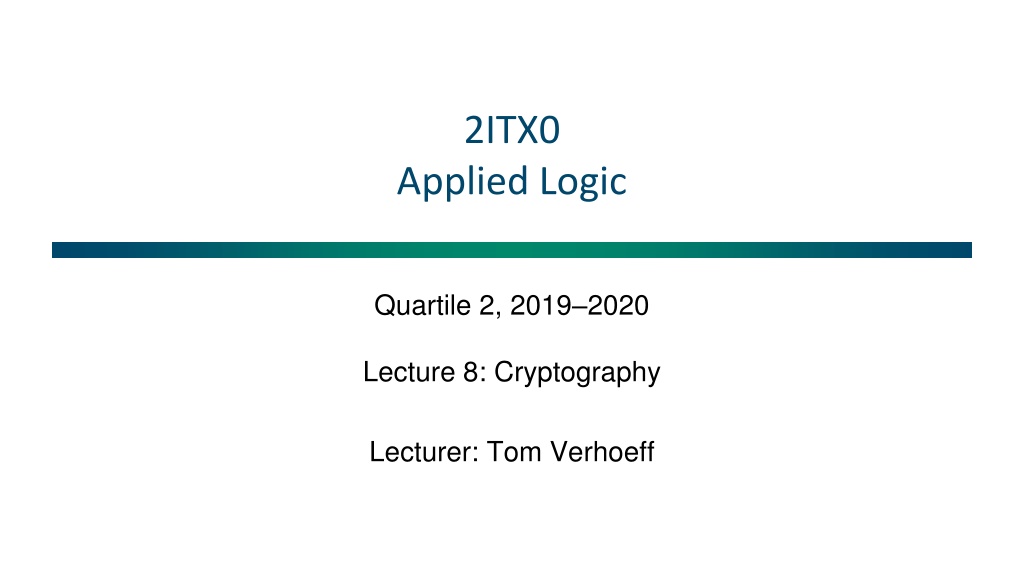
 undefined
undefined








